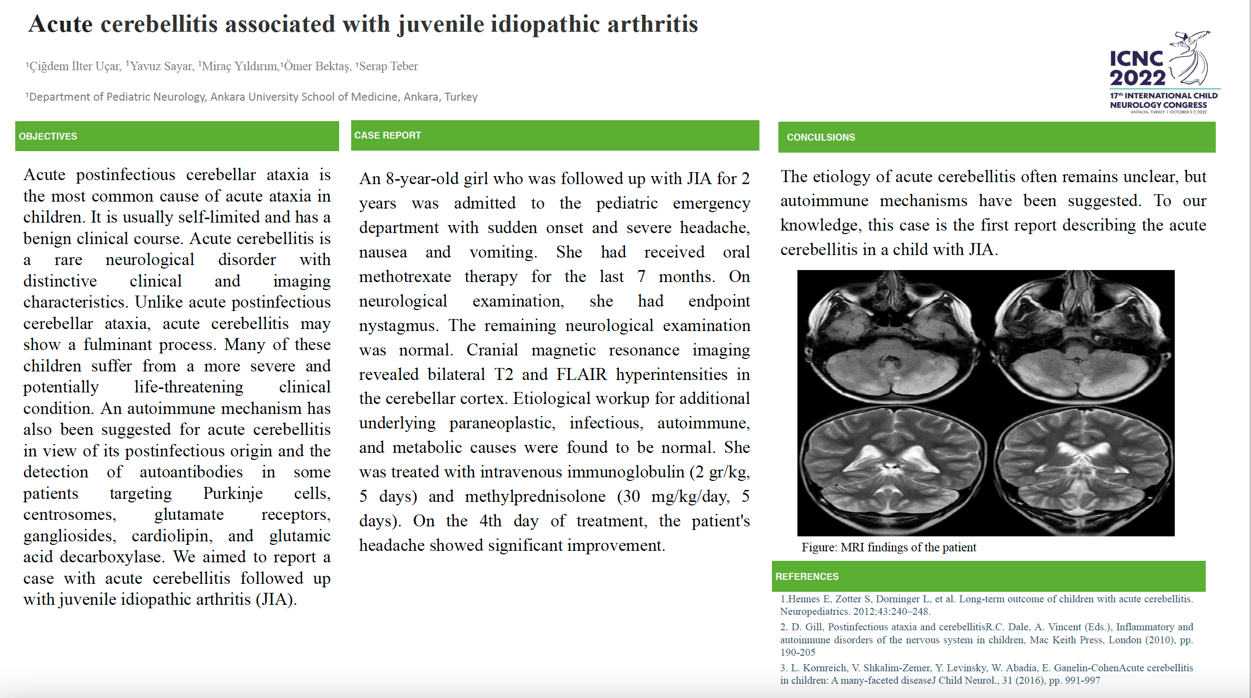Acute cerebellitis associated with juvenile idiopathic arthritis
Çiğdem İlter Uçar, Yavuz Sayar, Miraç Yıldırım, Ömer Bektaş, Serap Teber
Objectives: Acute cerebellitis is a rare neurological disorder with distinctive clinical and imaging characteristics. Acute postinfectious cerebellar ataxia is the most common cause of acute ataxia in children. It is usually self-limited and has a benign clinical course. On the other hand, acute cerebellitis may show a fulminant process. We aimed to report a case with acute cerebellitis followed up with juvenile idiopathic arthritis (JIA). Case presentation: An 8-year-old girl who was followed up with JIA for 2 years was admitted to the pediatric emergency department with sudden onset and severe headache, nausea and vomiting. She had received oral methotrexate therapy for the last 7 months. On neurological examination, she had endpoint nystagmus. The remaining neurological examination was normal. Cranial magnetic resonance imaging revealed bilateral T2 and FLAIR hyperintensities in the cerebellar cortex. Etiological workup for additional underlying paraneoplastic, infectious, autoimmune, and metabolic causes were found to be normal. She was treated with intravenous immunoglobulin (2 gr/kg, 5 days) and methylprednisolone (30 mg/kg/day, 5 days). On the 4th day of treatment, the patient's headache showed significant improvement. Conclusion: The etiology of acute cerebellitis often remains unclear, but autoimmune mechanisms have been suggested. To our knowledge, this case is the first report describing the acute cerebellitis in a child with JIA.
Keywords: Acute cerebellitis, children, juvenile idiopathic arthritis
Çiğdem İlter Uçar
Ankara University School of Medicine
Turkey
Yavuz Sayar
Ankara University School of Medicine
Turkey
Miraç Yıldırım
Ankara University School of Medicine
Turkey
Ömer Bektaş
Ankara University School of Medicine
Turkey
Serap Teber
Ankara University School of Medicine
Turkey
Objectives: Acute cerebellitis is a rare neurological disorder with distinctive clinical and imaging characteristics. Acute postinfectious cerebellar ataxia is the most common cause of acute ataxia in children. It is usually self-limited and has a benign clinical course. On the other hand, acute cerebellitis may show a fulminant process. We aimed to report a case with acute cerebellitis followed up with juvenile idiopathic arthritis (JIA). Case presentation: An 8-year-old girl who was followed up with JIA for 2 years was admitted to the pediatric emergency department with sudden onset and severe headache, nausea and vomiting. She had received oral methotrexate therapy for the last 7 months. On neurological examination, she had endpoint nystagmus. The remaining neurological examination was normal. Cranial magnetic resonance imaging revealed bilateral T2 and FLAIR hyperintensities in the cerebellar cortex. Etiological workup for additional underlying paraneoplastic, infectious, autoimmune, and metabolic causes were found to be normal. She was treated with intravenous immunoglobulin (2 gr/kg, 5 days) and methylprednisolone (30 mg/kg/day, 5 days). On the 4th day of treatment, the patient's headache showed significant improvement. Conclusion: The etiology of acute cerebellitis often remains unclear, but autoimmune mechanisms have been suggested. To our knowledge, this case is the first report describing the acute cerebellitis in a child with JIA.
Keywords: Acute cerebellitis, children, juvenile idiopathic arthritis
Çiğdem İlter Uçar
Ankara University School of Medicine
Turkey
Yavuz Sayar
Ankara University School of Medicine
Turkey
Miraç Yıldırım
Ankara University School of Medicine
Turkey
Ömer Bektaş
Ankara University School of Medicine
Turkey
Serap Teber
Ankara University School of Medicine
Turkey

Çiğdem İlter Uçar
Ankara University School of Medicine Turkey
Ankara University School of Medicine Turkey